The Caste System in India

In modern India many social evils exist which have been responsible for crippling a social system that has roots in an age-old glorious civilization. One such social evil, which at times seems to have entrenched itself and become part and parcel of the Indian people’s psyche, is the abominable caste system.
I believe that anyone who has visited India or anyone who has any knowledge of Indian social practices must have encountered the concept of caste system. If not, then one can readily find a huge amount of material to read about the atrocities and injustices prevalent and perpetuated in the name of the caste system in India.
Such division was based on one’s occupation and was somewhat similar to the logic of division of labor. But this division has been viewed by most until now as hierarchical or might have been so in reality since the conception of this system.
Put simply, the most rational logic behind such divisions of a society might have been that different people in a community should take up different responsibilities or jobs for the smooth functioning of society and its welfare. But to most of us it seems that such an understanding is very naïve and cannot be the real motive behind a social system which has been used to perpetrate heinous atrocities since time immemorial.
However, it can also be opined that, over time, the rationale behind innovating the Varna system started to change to such an extent that it was readily misinterpreted to serve the ulterior motives of the people who belonged to higher social classes. And accordingly it has been misunderstood by each and every member of society until now.
In our contemporary understanding and practice, caste is decided by birth and no longer by occupation. And this is the root cause behind all the atrocities and irrational practices that are justified under the pretext of the caste system. Assigning caste by birth first of all leads to a concretization of the system in a very distorted form and then its entrenchment. It results in depriving those assigned a lower category in the hierarchical caste system of their right to choose any occupation, and forces them towards a life of destitution, exploitation and humiliation by the members of the upper castes.
In earlier times, a person born in a Shudra family was not allowed access to education and had to continue the family occupation. However, this changed gradually over time and in contemporary India everyone has the right to education. In fact, people belonging to so-called lower castes are nowadays given subsidies in the education system to enable them to compete with those from upper castes who have enjoyed benefits and opportunities for a long time. In fact, caste politics is a very important part of the Indian political scenario.
An important manifestation of the influence and power of the caste system can be found in marriage practices in India. It is a reality that in India marriage between different castes is usually not welcomed. Indians who are orthodox in their perspectives prefer to marry someone from their own caste. This situation is not universal but a majority of the population marry someone from their own castes. In fact, many societies strongly oppose inter-caste marriage and at times extreme steps are taken to prevent and punish those who choose to marry outside of their castes.
In fact, even after tremendous efforts and much legislation, the caste system is still in place in Indian society. Many practices that emanate from the system are now punishable offences in India and thus contained. But the caste system seems to have pervaded the psyche of many Indians who still discriminate on the basis of a person’s caste.
Credits
| Image | Title | Author | License |
|---|---|---|---|
 |
Varanasi_2 | TimBrighton | CC BY-SA 2.0 |
